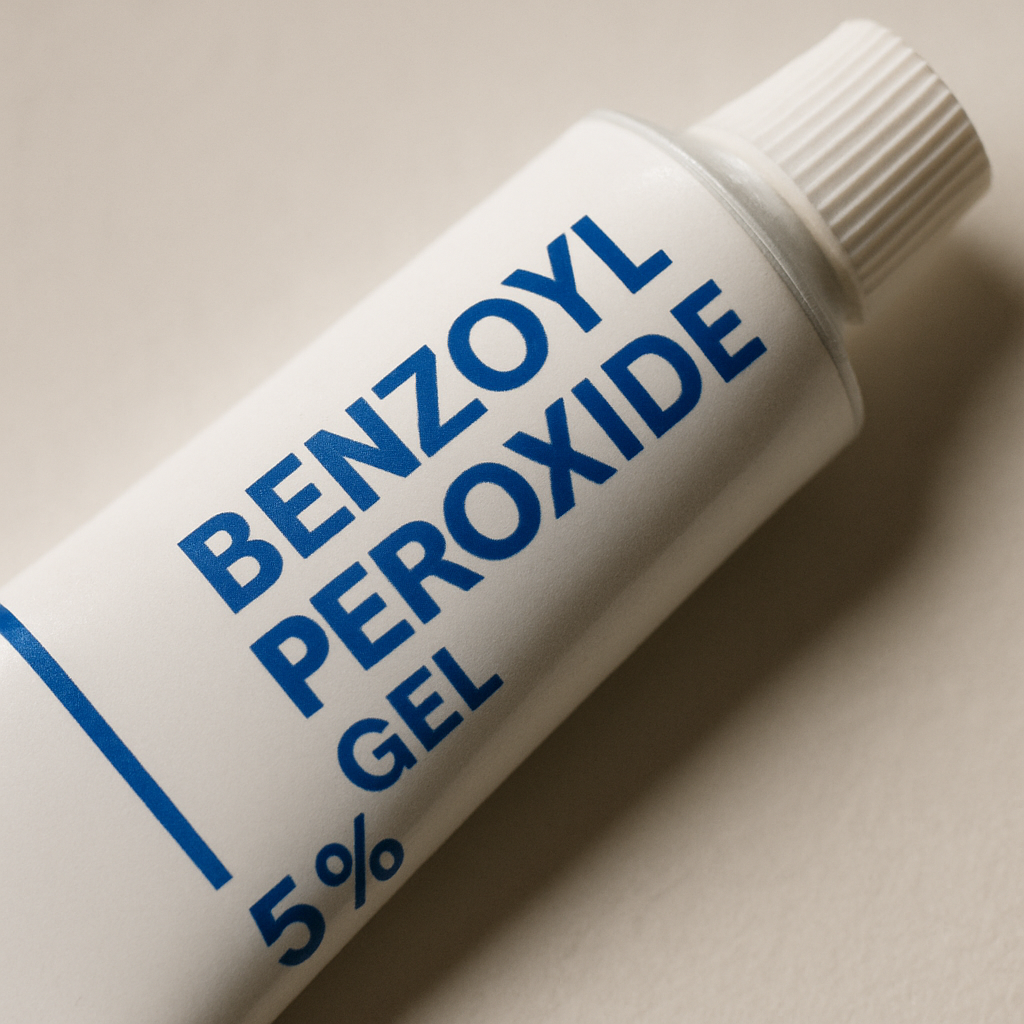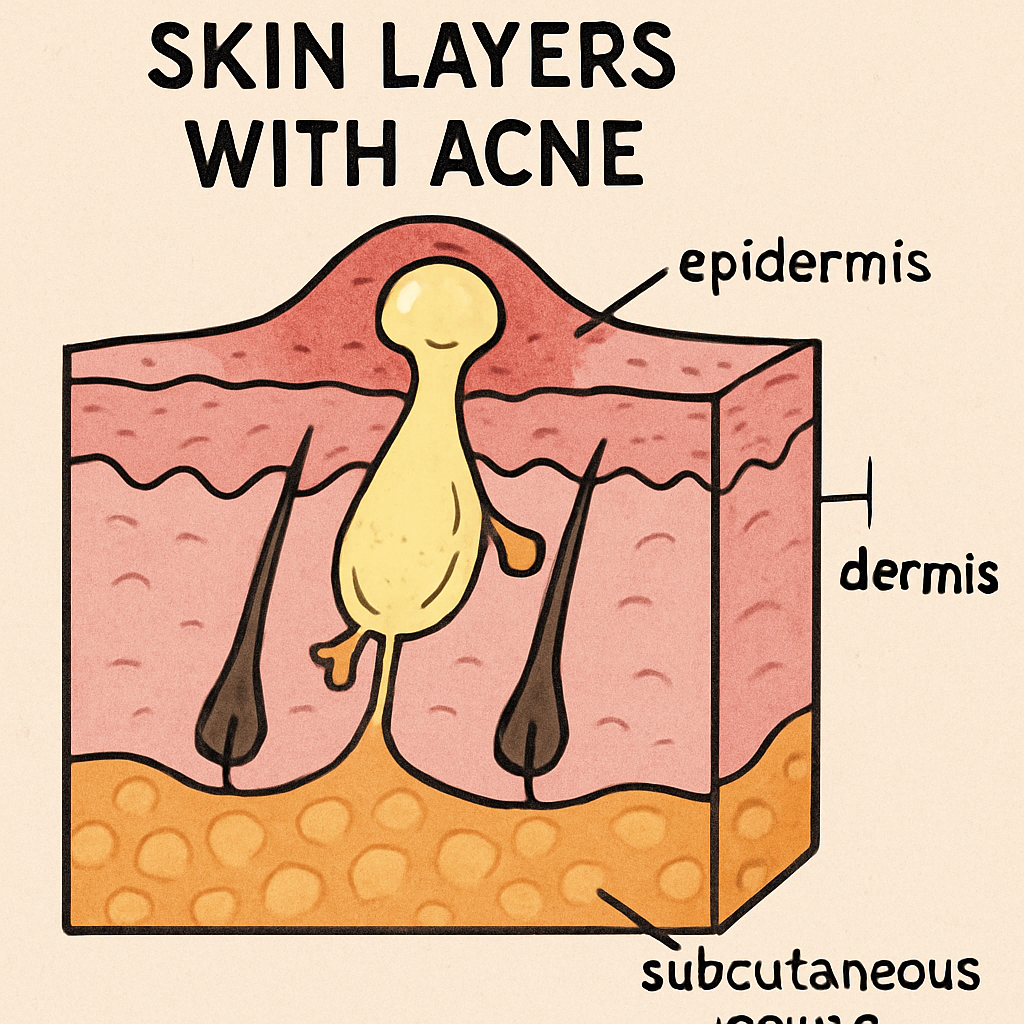Acne can be a relentless adversary, but with the right strategies, it can be managed effectively. Among the arsenal of treatments, benzoyl peroxide and adapalene have proven to be potent allies. In this article, we’ll explore whether you can use adapalene and benzoyl peroxide together, their benefits, and how they can be a part of your acne solution.

What is Benzoyl Peroxide?
Benzoyl peroxide is a powerful topical treatment widely used in acne management. It works by killing acne-causing bacteria and reducing inflammation. Additionally, it helps to unclog pores by removing dead skin cells, thereby preventing new acne breakouts. Moreover, benzoyl peroxide has mild keratolytic effects, which means it can help to exfoliate the skin’s surface, promoting a clearer complexion. Its antibacterial properties make it a staple in many over-the-counter and prescription acne treatments, offering both quick and long-term benefits.
How Does Benzoyl Peroxide Work?
The mechanism of benzoyl peroxide involves the release of oxygen into the pores. This oxygen-rich environment is hostile to the anaerobic bacteria responsible for acne, significantly reducing their numbers. Furthermore, benzoyl peroxide’s oxidizing ability not only targets bacteria but also aids in the removal of excess oils and debris from the skin’s surface. This multifaceted approach not only treats existing acne but also prevents future breakouts.
What is Adapalene?
Adapalene, on the other hand, is a type of retinoid. Retinoids are derivatives of vitamin A and are known for their ability to promote skin cell turnover. Adapalene helps to prevent the formation of acne lesions by keeping pores clear and reducing inflammation. This retinoid is particularly beneficial for its stability in sunlight, making it suitable for daily use. It also has less irritating properties compared to other retinoids, making it a preferred choice for those with sensitive skin.
The Science of Adapalene
Adapalene modulates cell differentiation and keratinization, which are critical processes in the formation of acne. By normalizing these processes, adapalene reduces the clogging of pores and prevents the formation of new acne lesions. Additionally, its anti-inflammatory properties help to calm irritated skin, reducing redness and swelling associated with acne. The efficacy of adapalene in promoting even skin tone and texture makes it a valuable addition to any acne treatment regimen.
Can You Use Adapalene and Benzoyl Peroxide Together?
The question on many acne sufferers’ minds is whether these two treatments can be used in tandem. The answer is a resounding yes. In fact, combining benzoyl peroxide and adapalene can be more effective than using either treatment alone.
How Do They Work Together?
When used together, benzoyl peroxide and adapalene complement each other. Benzoyl peroxide targets and reduces the bacteria that cause acne, while adapalene regulates skin cell turnover and unclogs pores. This dual-action approach can lead to clearer skin over time. Benzoyl peroxide also enhances the penetration of adapalene into the skin, making the combination more potent. This synergy not only accelerates the healing of existing acne but also fortifies the skin against future outbreaks.
The Science Behind the Combination
Studies have shown that using adapalene and benzoyl peroxide together can lead to significant improvements in acne symptoms. The combination targets different causes of acne, making it a comprehensive approach to acne treatment. Clinical trials have demonstrated a reduction in inflammatory and non-inflammatory acne lesions, underscoring the efficacy of this combination. The dual mechanism of action ensures that both surface-level and deeper skin issues are addressed, providing a holistic acne management strategy.
Advantages Over Single Treatments
While each treatment is effective on its own, their combination offers enhanced benefits. The ability to target multiple acne-causing factors simultaneously results in faster and more noticeable improvements. Patients often report less recurrence of acne when using both treatments, as opposed to monotherapy. This comprehensive approach not only treats but also prevents acne, providing long-term skin health benefits.
Benefits of Benzoyl Peroxide and Adapalene

Reduction of Acne Lesions
One of the most noticeable benefits of using benzoyl peroxide and adapalene is the reduction in acne lesions. By tackling the root causes of acne, these treatments can significantly decrease the number of pimples and blackheads. The reduction in lesions often leads to improved skin confidence and a more positive self-image. Consistent use can also minimize the risk of acne scars, preserving the skin’s natural texture and tone.
Prevention of Future Breakouts
Preventing future breakouts is a critical component of any acne treatment plan. Benzoyl peroxide and adapalene help to maintain clear skin by keeping pores free from blockages and reducing the presence of acne-causing bacteria. This preventative aspect is crucial for individuals prone to frequent acne flare-ups. By establishing a routine that includes these treatments, users can enjoy prolonged periods of clear skin, reducing the emotional and physical toll of acne.
Improvement in Skin Texture
Regular use of these treatments can also improve the overall texture of your skin. With a reduction in inflammation and smoother skin cell turnover, your skin can appear healthier and more radiant. The exfoliating effect of benzoyl peroxide coupled with adapalene’s ability to promote new skin growth results in a softer, more even complexion. Over time, users may notice a decrease in the appearance of fine lines and hyperpigmentation, contributing to youthful-looking skin.
Enhanced Skin Clarity
Beyond just treating acne, these treatments can enhance overall skin clarity. By consistently clearing out pores and reducing oil production, benzoyl peroxide and adapalene help achieve a more uniform skin tone. This clarity is not only about reducing acne but also about promoting an even complexion free from blemishes and discoloration. The comprehensive approach ensures that the skin remains balanced, reducing the likelihood of other skin issues.
How to Use Benzoyl Peroxide and Adapalene Gel
Step-by-Step Application
Using these treatments correctly is crucial for achieving the best results. Here’s a simple guide:
- Cleanse Your Skin: Begin with a gentle cleanser to remove any dirt and oil from your face. Choose a non-comedogenic cleanser that won’t clog your pores, ensuring that your skin is prepped for treatment.
- Apply Adapalene: Use a pea-sized amount of adapalene gel and apply it evenly across your face, avoiding sensitive areas like the eyes and mouth. Focus on areas prone to breakouts, ensuring even coverage to maximize effectiveness.
- Wait for Absorption: Allow the adapalene to fully absorb into your skin before proceeding. This usually takes a few minutes, providing time for the active ingredients to penetrate your skin layers effectively.
- Apply Benzoyl Peroxide: Follow with a thin layer of benzoyl peroxide gel on the affected areas. Apply gently to avoid irritation, and remember that a little goes a long way in treating acne.
- Moisturize: After the treatments have absorbed, apply a non-comedogenic moisturizer to help keep your skin hydrated and to minimize potential dryness or irritation.
Frequency and Timing
For optimal results, use these treatments once daily, preferably in the evening. This routine allows the active ingredients to work overnight, reducing potential irritation from sun exposure during the day. Starting with nighttime application also allows your skin to gradually adjust to the new treatment, minimizing the risk of adverse reactions. As your skin builds tolerance, you may consider incorporating the treatment into your morning routine, but always follow with sunscreen to protect against UV damage.
Adjusting Your Routine
As your skin adapts, you may need to adjust the frequency and amount of product used. Begin with every other night to monitor your skin’s response, slowly increasing as tolerated. Pay attention to how your skin reacts and be willing to modify your routine if necessary. Consulting with a dermatologist can provide personalized advice to ensure you achieve the best results without compromising your skin’s health.
Potential Side Effects and Precautions

by Wilhelm Gunkel (https://unsplash.com/@wilhelmgunkel)
Common Side Effects
While benzoyl peroxide and adapalene are effective, they can cause some side effects, particularly when first used. These may include dryness, redness, and peeling. These effects typically subside as your skin adjusts to the treatment. It’s crucial to introduce the treatments gradually to allow your skin to build tolerance. In some cases, a temporary increase in acne can occur, known as purging, as your skin clears out underlying impurities.
Minimizing Irritation
To minimize irritation, start by using the treatments every other day and gradually increase to daily use. Additionally, apply a moisturizer after the treatments to help keep your skin hydrated. Opt for a soothing moisturizer containing ingredients like hyaluronic acid or ceramides to reinforce your skin’s barrier. If you experience persistent irritation, consider reducing the frequency of application until your skin acclimates.
When to Consult a Dermatologist
If you experience severe irritation or your acne does not improve after several weeks, it may be time to consult a dermatologist. They can provide personalized advice and adjust your treatment plan as needed. Dermatologists can also suggest alternative therapies or adjunctive treatments to enhance your regimen. Professional guidance ensures your acne treatment is both effective and safe, minimizing the risk of long-term skin damage.
Recognizing Allergic Reactions
Be vigilant for signs of an allergic reaction, such as severe itching, swelling, or blistering. Discontinue use immediately and seek medical advice if these symptoms occur. Allergic reactions are rare but require prompt attention to prevent complications. Understanding your skin’s needs and sensitivities is key to avoiding adverse outcomes and ensuring a successful acne treatment journey.
Conclusion: An Effective Acne Solution
Combining benzoyl peroxide and adapalene offers a powerful solution for managing acne. By addressing multiple causes of acne, from bacteria to clogged pores, this combination can lead to clearer, healthier skin. As with any skincare regimen, consistency is key, and patience is vital as you work towards your goal of acne-free skin.
Incorporate these treatments into your skincare routine and consult with a healthcare professional to ensure the best approach for your individual needs. With dedication, benzoyl peroxide and adapalene can be valuable tools in your fight against acne. Remember to adjust your routine based on your skin’s response and to prioritize skin health over rapid results. Achieving clear skin is a journey, and with the right strategies, it is within reach.

